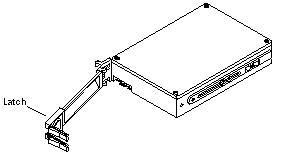Disk Drives
Removing a Disk Drive
-
Use the procedures described in, "Removing a Board", To remove the applicable Disk board.
-
Unlatch and open the ejector drive retainer on the drive to be replaced (Figure 5-8).
Using the extended drive retainer as a handle pull the drive straight out to disengage it from the board mating receptacle and the drive mounting bracket.
Figure 5-8 Disk Drive with Ejector Drive Retainer Open

-
If a new drive is to be installed, proceed to the next section.
If the drive is not to be replaced, replace the Disk board as described in "Installing a Board".
Installing a Disk Drive
-
Inspect the shipping container upon receipt of your drive, and look for evidence of damage.
If the carrier's agent is not present when the container is opened, and the contents are damaged, keep all contents and packing materials for the agent's inspection.
-
If there is no evidence of damage, carefully remove the drive from the shipping container.
Save the carton and the packing material for possible later use.
-
Place the antistatic mat on a table or work surface.
-
Attach a grounding wrist strap.
Refer to the documentation that came with your ESD kit.
-
Remove the disk drive from its protective packaging.
Hold the disk drive by the edges, near the middle of the drive. Keep the drive vertical until you lay it on the ESD mat.
-
Place it on the antistatic mat with the component side of the disk drive controller cards facing up.
-
Unlatch and then open the ejector drive retainer for the drive being replaced or installed (Figure 5-8).
-
Using the drive retainer as a handle, slide the drive in and then seat it to the board connector receptacle.
Close and latch the ejector drive retainer.
-
SCSI IDs for disk drives on Disk boards are selected on the Disk board.
See Appendix C, SCSI Devices to select the SCSI ID for the disk drive.
-
Check that the ejector drive retainers on both disk drives are closed, latched in place, and do not extend past the edge of the board.
If an ejector drive retainer extends past the edge of the Disk board or is not fully closed, the disk drive connector is not joined with the Disk board connector. Do the following:
-
Use the unlatched drive retainer to unseat the drive from the board connector receptacle and slide it out an inch or two.
-
Check that the connectors are not broken and that nothing blocks the joining of these two connectors.
If there is a problem, put the disk drive back into its protective packaging, and contact your service representative.
Note -Save the antistatic shipping bag and other original packing. You will need these materials when transporting the disk drive.
-
-
Terminate the SCSI-out connector, if necessary.
The SCSI-out connector on Disk boards that are not daisy chained to an additional device must be terminated with a SCSI terminator. See Figure 5-3.
Note -The last or only disk board in a system must have the SCSI out connector terminated with a fast-wide SCSI terminator, part number 150-2267.
-
Replace the Disk board as described in "Installing a Board".
- © 2010, Oracle Corporation and/or its affiliates
